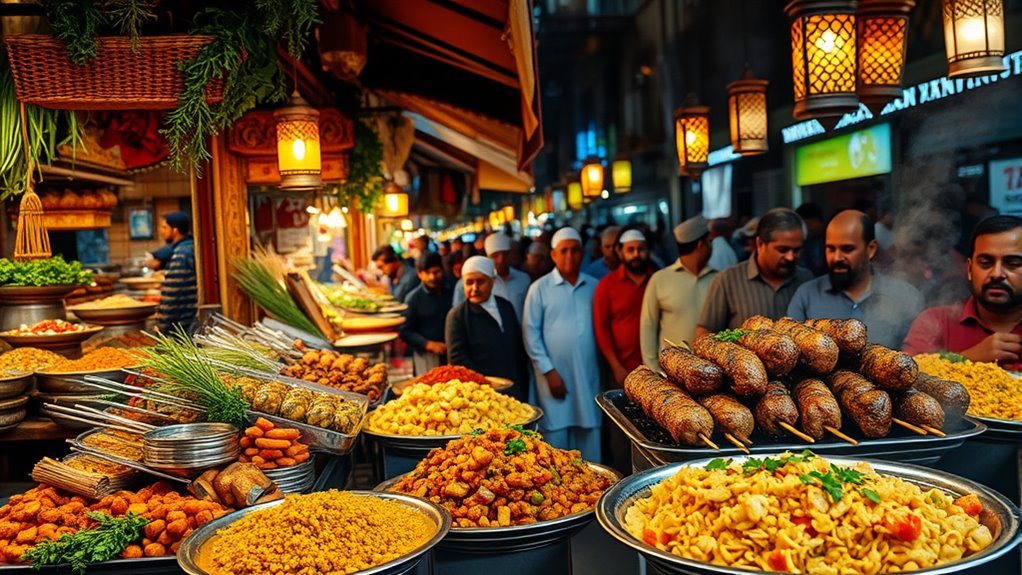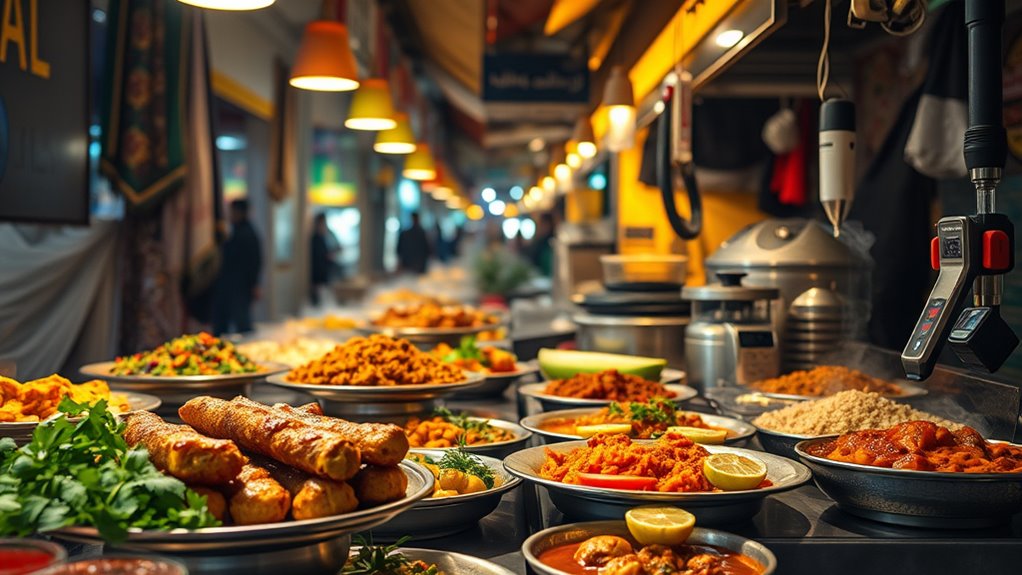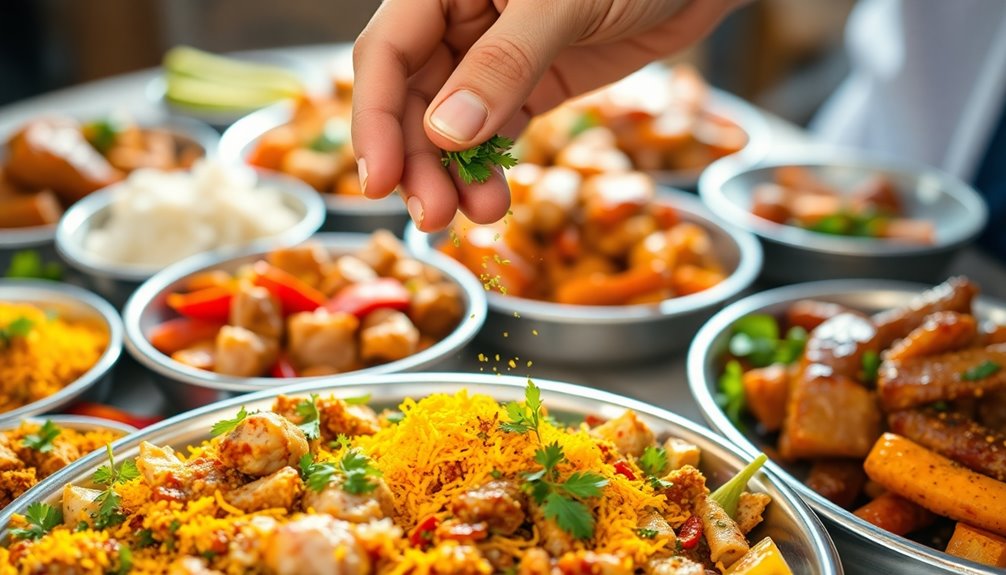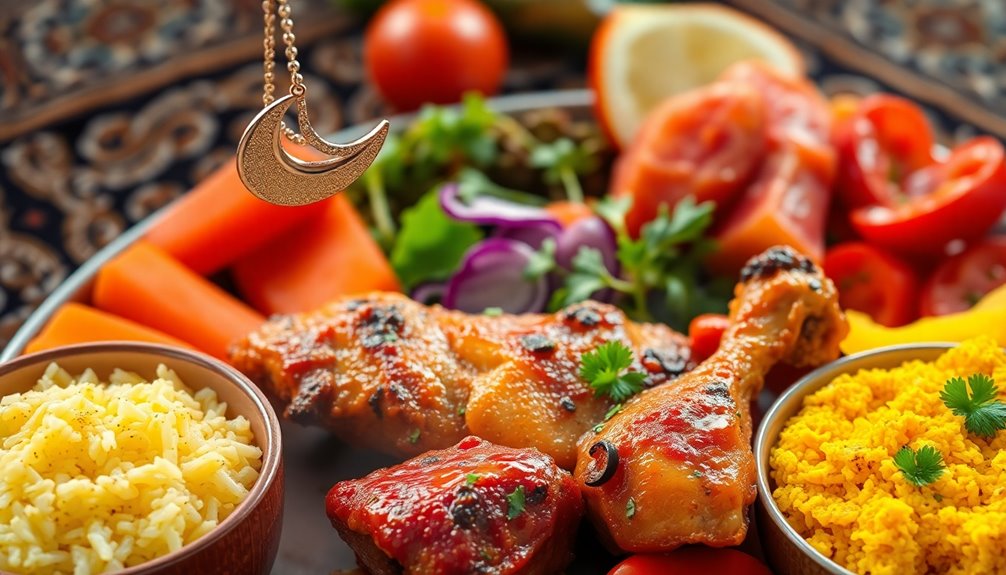Halal food in India and Pakistan blends rich history, faith, and vibrant flavors. Influenced by centuries of Islamic culture, it features spiced dishes like biryani, kebabs, and curries made with authentic ingredients and traditional cooking techniques. Street markets and local vendors serve flavorful, halal-certified street foods that reflect regional customs. Modern innovations like plant-based options and sustainable sourcing keep these culinary traditions alive. Discover how faith and flavor come together in every bite as you explore further.
Key Takeaways
- Halal cuisine in India and Pakistan reflects centuries of Islamic influence, blending religious dietary laws with regional ingredients and flavors.
- Key ingredients like cumin, coriander, turmeric, and traditional cooking techniques such as slow braising define authentic halal dishes.
- Modern innovations include fusion flavors, plant-based alternatives, and safety technologies, maintaining tradition while embracing contemporary trends.
- Street markets and local vendors play a vital role in preserving vibrant halal culinary culture through diverse, authentic offerings.
- Cultural pride, community engagement, and sustainable practices ensure halal food remains relevant, flavorful, and deeply rooted in regional identity.
The Historical Roots of Halal Cuisine in South Asia

The historical roots of halal cuisine in South Asia trace back to the advent of Islamic culture and the spread of Muslim rule in the region. During this period, Muslim rulers and traders brought their culinary traditions, influencing local food practices. This Muslim historical influence fostered a rich cultural exchange, blending Islamic dietary laws with native ingredients and flavors. As a result, halal food became deeply integrated into regional cuisines, shaping cooking methods and dishes that persist today. You can see this influence in the diverse, flavorful dishes that emphasize meat prepared according to halal principles. This culinary heritage reflects centuries of interaction between cultures, creating a unique gastronomic identity that continues to thrive across India and Pakistan. Additionally, the adherence to halal food standards has ensured that these culinary traditions remain aligned with religious practices, reinforcing the importance of religious dietary laws in shaping regional cuisine. The preservation of these traditions also highlights the importance of cultural continuity in maintaining culinary identity over generations. Furthermore, understanding the significance of regional culinary influences helps in appreciating the diversity and richness of South Asian halal cuisine. Recognizing the role of traditional cooking techniques further underscores how historical practices continue to influence modern halal food preparation.
Key Ingredients and Cooking Techniques in Halal Food

You’ll notice that key spices like cumin, coriander, and turmeric define the flavor of halal dishes. Traditional cooking methods, such as slow braising and grilling, bring out rich tastes and textures. Understanding these ingredients and techniques helps you appreciate the depth of halal cuisine in India and Pakistan. Incorporating herbal teas into meal routines can enhance digestion and overall well-being. Additionally, the use of Vetted electric bike conversion kits reflects the importance of reliable and efficient tools in contemporary lifestyle choices, paralleling traditional culinary practices with modern innovations.
Essential Halal Spices
Essential halal spices form the backbone of authentic dishes in India and Pakistan, imparting rich flavors and aroma that define their culinary identity. You’ll find that spice blending is key to creating complex flavor profiles, combining ingredients like cumin, coriander, turmeric, and cardamom. These spices are carefully selected and balanced to enhance the dish’s taste while respecting halal principles. The aromatic spices not only add depth but also carry cultural significance, reflecting regional traditions. When cooking halal food, you focus on layering these spices at different stages, ensuring each flavor develops fully. This mastery of spice blending elevates simple ingredients into vibrant, flavorful dishes that honor faith and tradition. Additionally, the use of authentic vetted spices ensures the dishes adhere to halal standards, maintaining both quality and faithfulness to traditional recipes. Proper spice blending techniques are also essential to achieve the desired aroma and flavor complexity in halal cuisine. Moreover, understanding the appropriate cooking methods for these spices helps preserve their essential qualities and enhances overall dish authenticity. Incorporating mindful cooking practices can further elevate the sensory experience and uphold the spiritual significance of halal cooking. Being aware of global economic factors can also influence the availability and quality of spices, ensuring consistent adherence to halal standards.
Traditional Cooking Methods
Traditional cooking methods in halal cuisine of India and Pakistan rely heavily on slow simmering, dry roasting, and steaming techniques that preserve the integrity of key ingredients. These methods enhance flavors and guarantee authenticity, often blending traditional techniques with fusion approaches. You might notice how spices are toasted to deepen aroma, or how dishes are steamed to retain moisture and nutrients. Presentation styles are equally important, with vibrant garnishes and layered plating highlighting the artistry involved. Incorporating fusion techniques, such as combining local spices with international culinary influences, adds a modern twist to classic dishes. By respecting these traditional methods, you preserve the cultural essence while embracing innovative culinary expressions that appeal to diverse palates. Techniques like sound synthesis can be employed to creatively develop new flavor profiles in contemporary culinary innovation, blending tradition with modernity.
Popular Halal Dishes Across India and Pakistan

Across India and Pakistan, halal cuisine features a diverse array of flavorful dishes that reflect the rich culinary heritage of the region. Popular dishes like biryani, kebabs, and nihari showcase the unique blend of spices and cooking techniques passed down through generations. You’ll find fusion cuisine emerging, combining traditional ingredients with modern twists to appeal to evolving tastes. Many dishes are prepared with respect for dietary restrictions, ensuring they meet halal standards while still offering bold flavors. Understanding of food safety standards in these regions helps maintain quality and authenticity in halal cuisine. In Pakistan, dishes like haleem and chapli kebabs are favorites, while in India, you might enjoy Mughlai-style chicken or goat curries. These dishes celebrate cultural diversity and culinary artistry, making halal food an integral part of regional identity and shared flavors across both countries. Additionally, cultural significance of food plays a vital role in preserving traditional cooking methods and community bonds in these regions. Moreover, perseverance and cultural pride are often reflected in the dedication to maintaining traditional culinary practices amidst modern influences.
The Role of Street Food and Local Markets in Halal Culinary Culture

Street food stalls and local markets are the heartbeat of halal culinary culture in India and Pakistan. They offer authentic experiences and showcase traditional cooking practices that have been passed down through generations. Exploring these vibrant spaces gives you a true taste of regional flavors and halal offerings. Engaging with vendors and observing traditional cooking practices can deepen your appreciation for the cultural significance of halal cuisine in these regions. Moreover, the local food environment plays a crucial role in maintaining the authenticity and accessibility of halal foods for communities and visitors alike. For example, many markets emphasize community-based sourcing, which ensures that ingredients are both fresh and ethically obtained. Additionally, these markets often support sustainable food sourcing practices, ensuring that fresh ingredients are readily available and ethically obtained. Many vendors also prioritize noise levels of modern heat pumps, ensuring that their cooking environments remain comfortable and efficient without causing disturbance to nearby residents.
Authentic Street Food Experiences
Street food and local markets play a vital role in shaping halal culinary culture in India and Pakistan, offering authentic flavors that reflect everyday life and community traditions. When you explore these vibrant stalls, you’ll notice how food presentation by street food vendors enhances the experience, making dishes both visually appealing and delicious. The lively atmosphere, aroma, and artistry in serving create an immersive cultural journey. You can savor everything from spicy kebabs to sweet jalebis, all prepared fresh and halal-certified. These experiences aren’t just about eating—they’re about connecting with local customs, enjoying genuine hospitality, and tasting the soul of the community. To deepen your experience, consider:
- Watching street food vendors craft dishes with skill
- Engaging with vendors for authentic recipes
- Sampling diverse, halal street food delicacies
- Observing food presentation techniques that elevate the dining experience
Local Market Halal Offerings
Local markets in India and Pakistan serve as vibrant hubs where halal food offerings flourish, reflecting the rich culinary traditions of the region. As you explore these bustling spaces, you’ll find a variety of halal offerings from street vendors and local stalls. These markets showcase the diversity of flavors, from spicy kebabs to savory curries, all prepared in accordance with halal principles. The lively atmosphere invites you to sample authentic dishes directly from vendors who take pride in their culinary heritage. You can easily identify halal options through signage or vendor reputation, ensuring your dietary needs are met. Visiting these local markets gives you an immersive experience of the region’s food culture, highlighting how halal offerings are woven into everyday life.
Culinary Traditions and Practices
In markets bustling with activity, traditional culinary practices come alive through the vibrant street food scene and local vendors. Here, you’ll find a rich tapestry of flavors shaped by halal dietary regulations and regional influences. Street stalls often serve fusion cuisines, blending local spices with international techniques, creating unique dishes that honor faith and tradition. You might notice vendors carefully adhering to halal standards, ensuring every bite aligns with dietary laws. Local markets also reflect the evolving culinary landscape, where heritage meets innovation. These practices foster community bonding and preserve authentic flavors. Whether sampling spicy kebabs or sweet desserts, you experience how street food embodies the heart of halal culinary culture, celebrating faith while embracing culinary creativity. Additionally, unique and wicked planters symbolize the diverse creativity that can be found in culinary presentation and innovation.
Modern Trends and Innovations in Halal Food Preparation

Modern trends and innovations are transforming halal food preparation in India and Pakistan, driven by technological advancements and changing consumer preferences. You’ll see fusion gastronomy gaining popularity, blending traditional flavors with international cuisines to create exciting new dishes. Plant-based innovations are also making a significant impact, offering halal-certified meat alternatives that cater to health-conscious and ethical consumers. Chefs and food entrepreneurs are experimenting with these trends to meet demand for diverse and modern halal options. Automation and improved food safety technologies ensure higher standards and efficiency in halal food processing. These innovations help you enjoy flavorful, innovative dishes without compromising your faith or taste preferences. As a result, halal cuisine continues to evolve, embracing modernity while respecting its rich cultural roots.
Preserving Tradition: Cultural Significance of Halal Practices

Preserving the tradition of halal practices holds deep cultural and spiritual significance for communities in India and Pakistan. It’s more than just food—it’s about honoring religious rituals and strengthening community bonds. Through these practices, you connect with your heritage and uphold values passed down generations. Halal methods symbolize respect for life and faith, playing a essential role during community celebrations and religious festivals. They serve as a reminder of shared identity and devotion. By maintaining these traditions, you ensure their survival amidst modern influences. The ritual slaughtering process, specific prayer recitations, and communal participation reinforce the cultural fabric. These practices foster unity and respect, making halal food a cornerstone of cultural expression across India and Pakistan.
Frequently Asked Questions
How Do Halal Certification Standards Vary Between India and Pakistan?
You’ll find that halal certification processes differ between India and Pakistan due to regional regulatory differences. In India, certification standards are often governed by multiple bodies, emphasizing strict adherence to Islamic guidelines, but vary regionally. Pakistan has a centralized authority that standardizes halal certification nationwide, ensuring consistency. These regional regulatory differences influence how halal standards are applied, impacting certification procedures and consumer trust in each country.
What Are Common Misconceptions About Halal Food in South Asia?
You might think all halal food is the same, but cultural perceptions and concerns about halal authenticity vary widely. Many believe halal standards are strict everywhere, but misconceptions persist about how it’s prepared and certified. Some think halal food is only religiously approved, ignoring cultural influences. Clarifying these misconceptions helps you appreciate the diverse practices across regions, ensuring you trust halal food’s authenticity wherever you enjoy it.
How Does Halal Cuisine Influence Regional Food Identities?
You might think halal cuisine diminishes regional food identities, but it often fuels cultural fusion instead. When you explore halal dishes, you see how they incorporate local ingredients and flavors, enriching culinary authenticity. This blending creates unique regional identities that celebrate faith and tradition, showcasing diversity rather than erasing it. Halal food consequently acts as a bridge, connecting communities through shared culinary practices while preserving distinct regional flavors and cultural stories.
Are There Specific Festivals Celebrating Halal Food Traditions?
You’ll find that many regions host Halal food festivals, celebrating Halal culinary traditions with vibrant displays of dishes and cultural performances. These festivals highlight the significance of Halal food traditions in local communities, bringing people together to enjoy shared flavors and heritage. By attending these events, you get to experience diverse Halal food festivals firsthand, deepening your understanding of how Halal cuisine plays a crucial role in regional identities and cultural celebrations.
How Is Halal Food Adapting to Global Dietary Trends?
You might think halal food just sticks to tradition, but it’s surprisingly evolving. As global trends lean toward plant-based options and sustainable sourcing, halal cuisine adapts effortlessly. You’ll find innovative dishes that honor faith while embracing health and eco-consciousness. This blend of faith and flavor now appeals to a broader audience, proving that halal food remains vibrant and relevant, even in a world obsessed with sustainability and ethical choices.
Conclusion
You see, halal food in India and Pakistan isn’t just about tradition; it’s a vibrant tapestry blending faith and flavor. While modern trends bring innovation, the deep-rooted cultural practices remind you of a time when food was sacred. Amid bustling markets and street stalls, you feel the heartbeat of a rich heritage. It’s this harmony of old and new that keeps the spirit of halal culinary culture alive, inspiring both loyalty and hope.









